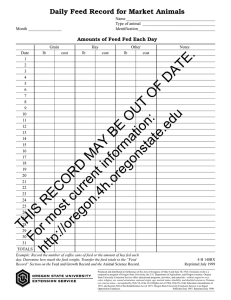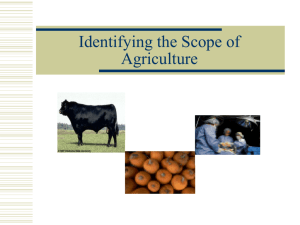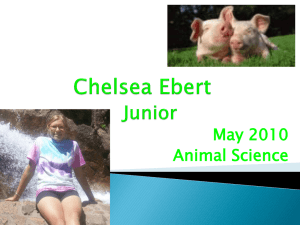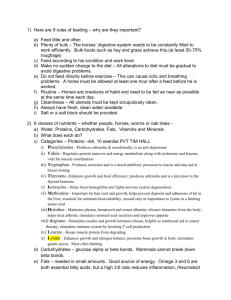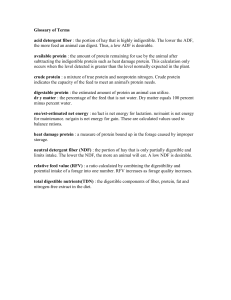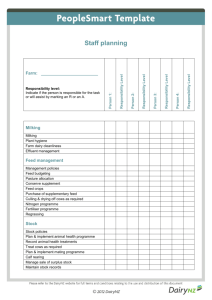and Cows Ranchers, Ranges,
advertisement
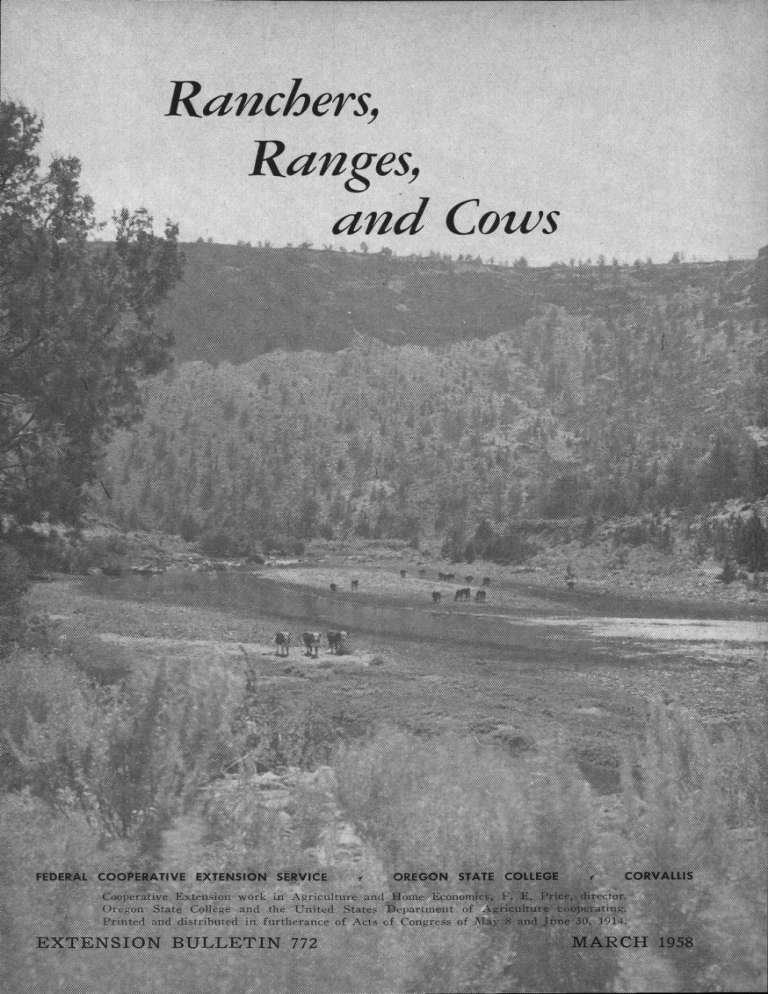
t Ranchers, Ranges, and Cows FEDERAL COOPERATIVE EXTENSION SERVICE 1 OREGON STATE COLLEGE f CORVALLIS Cooperative Extension work in Agriculture and Home Economics. F. E. Price, director. Oregon State College and the °United States Department of Agriculture cooperating. Printed and distributed in furtherance of Acts of Congress of Pray 8 and June 30, 1914. EXTENSION BULLETIN 772 MARCH 1958 Foreword This is the second in a series of Oregon Extension bulletins on ranges and range management. The first was "Grass is the Wealth," Oregon State College Extension Bulletin 770. It covered some principles of grass growth. This bulletin, "Ranchers, Ranges, and Cows," is about livestock in relation to range feed. It refers to cows in its title and content, but nearly all the information is equally applicable to sheep. Contents Page Foreword 2 Troubles in the Factory 4 Essentials of a Successful Meat Factory 7 A Year-round Plan Is Needed 11 A Rancher Is Lucky in Some Ways 11 Summary 12 Elgin Cornett, Deschutes County Extension Agent, Redmond, Oregon Art Sawyer, Superintendent, Squaw Butte-Harney Experiment Station, Burns, Oregon C. E. Poulton, Associate Professor of Range Management, Oregon State College, Corvallis, Oregon Joe Johnson, Associate Professor of Animal Husbandry, Oregon State College, Corvallis, Oregon E. R. Jackman, Extension Range Management Specialist, Oregon State College, Corvallis, Oregon 2 Ranchers, Ranges, and Cows Every factory produces something to sell. It uses tools and skilled labor to convert raw materials into some other product. The manager prevents wear and waste and keeps things moving. The factory fails unless the raw material comes along evenly, and it still fails unless the finished product is uniform and saleable. Every cattle rancher is in the business of producing something to sell. He is a factory manager. His raw materials are feed, his factory is his herd, and meat is the finished product. He uses foresight and planning to provide raw materials throughout the year. The rancher is in competition with every other rancher. If his costs are higher, or his product poorer than the average, he'd better check in his chips and hunt another game. This points to why range is importantit carries the lowest price tag of any of the raw materials used in the meat factory. Thus, the man with good range making up a high percentage of the meat he sells can usually beat a competitor who sells meat mostly built from grain and hay. 3 Troubles in the Factory Raw products may be slow in arriving, or of poor quality. Late spring usually finds these raw materials in the grass reasonably well Balanced rations are important to the meat factory. Raw materials contain protein, carbohydrates, fiber, cal- balanced with the needs of the animals. changes drastically from spring to fall. Also, as the seasons change, the total available amount of each nutrient in a mouthful of forage is likely to change. before super-markets and city consumers were invented. Late summer fades out grass protein and by fall it is nearly all gone. It is cium, phosphorous, fats, minerals, now long on energy, short on protein. water, and many minor things. A pro- At this time a cow will be nursing a duction slump comes if there is short- growing calf and also building a fetus age of only one of the nutrients in or new calf. This is a double load at feed, or if the supply of nutrients is the time forage strength is dropping. out of balance. In nature, the ratio of It seems as though nature slipped a one nutrient to another in range feeds cog, but maybe she planned all this This factory has a nearly constant The factory may be poorly maintained. Wintering stock cattle is factory as the nutrients in grass change rad- maintenance, getting ready for a proically with the seasons. In early spring, duction job on cheaper raw materials grass is weak and thin for growing in summer. It takes ample protein, demand for protein and energy, where- animals or cows with calves. It is long on protein, short on energy. ample fiber, and other nutrients to hold thrifty condition. Sometimes hay is not Plants of Normad alfalfa on severely overgrazed range, Klamath County. All perennial grasses were killed by overgrazing, but the alfalfa was not. Alfalfa keeps its protein late in the season, but grass does not. 4 equal to the wintering job if it is overmature or poorly preserved. Much as with a bank account or a pocket, you can't get any more out of a haystack than you put into it. A factory manager can handle both good and poor quality raw materials if he is skilful in making the good ones reinforce the poor. Capacity of a cow to hold plenty of forage in the grazing season is also valuable in the winter to handle average quality hay. Ordinary harvesters of this forage should be up to date. Livestock are similar to assembly line workers in that some seem to be working but accomplish little. Some cattle, for instance, gain twice as fast as others, and some produce a pound of meat on less than half as much forage as others. It so happens that rapidly gaining animals also tend to be efficient gainers and they usually pass on this know-how to their offispring. Therefore, one of the most effective grass hay properly cared for, has ways to send more forage to market enough protein to maintain a beef cow if she has large capacity. Poor hay will as meat, is to cull out the star boarders. With an improved herd each not maintain body weight without a pound of forage is used to best adprotein supplement. Suppose a man vantage. Just as in business and inwere to try to keep up his weight wintering on nothing but cabbage. It's dustry, a smaller number of highly efficient workers can produce more at less cost than a large number of goldbricks. good food of its kind, but he just couldn't eat enough of it. By spring There may be too much factory he'd have a lean streak in his bacon. Overfat beef cows are wasteful and expensive machines. Cows should be for the raw materials. Pressure for more income has caused weak ones must waste time in a bodyrepairing job when feed gets plentiful. rangements. Overgrazing is underfeeding and the problem is how to produce many a manager to increase factory thrifty and strong, but not fat. "Tail- units (animals) faster than his raw ing up" may be good exercise for the material justified. His sales organizacowboys, but not for the cows. The tion outstripped his production arProfit comes from best use of grass, the cheapest feed. The cow must be in best condition to take advantage of the cheap grass. Good condition results in strong, fast-gaining calves. A factory wouldn't use silk for a product where cotton would be better. Overfat discourages aggressive foraging out on the range, but overweakness means waste- ful repair and less meat to sell. So winter maintenance helps the cow during the first month or two on the range, and helps in getting big, healthy calves. Old-style factories are out of date. more forage on the land. Usually a manufacturing business can find ways to get more raw materials. A rancher can do it, too. It's hard work to balance cattle needs with the needs of the grass. The annual cattle-grazing cycle on the range is not parallel with the grass growth cycle. This unhappy conflict is the basic problem of a beef factory manager. He must look for management methods that will harmonize the two demands. The cows eat every day, but grass, the main raw material, grows only part of the year. Worse, the forage varies in quality with the season. Forage is the stuff marketed in a Still worse, what is good for the cows beef cattle or sheep operation, so the may not be best for the grass. For top 5 grass production, the grass must grow Also, the water in the forage up well before it is grazed off and changes. In the spring the forage is there should be plenty left on the plant. succulent and a cow may need 80 This builds strong healthy plants. Un- pounds a day to get 10 pounds of dry fortunately cattle needs are greatest matter. But if turned out too early, and forage cycle is weakest in the early when grass growth is small, cows just spring. In years of low rainfall, grass aren't fast enough to gather that much. may never recover if eaten to the They'd have to travel like sprinters. So ground in April. animals -on spring grass often lose Forage is high in growth factors weight. At the grass peak, in June, when green, high in energy when cured on the stem. But when cured, food and needs of the animal are well forage generally falls below the needs of the animal. A cow needing a pound In late summer and fall the meat factory most often gets off stride. Raw materials are less plentiful and of protein a (lay can get it and still in balance on a good range. spend most of the time lying down if poorer in quality. The calf in the cow feed is lush and tests over 10% pro- is bigger and the yearling steer needs tein. But when that feed ripens, and more for maintenance. The wise manprotein drops to 2%, she would have ager has stockpi ed some feed on the to eat five times as muchand her ground by reserving a pasture not used stomach won't hold that quantity, so even if feed seems plentiful in the fall, the animal may be losing flesh. If a factory needed iron and copper for a product, and it had only a fourth as much copper as it needed, it wouldn't help much to furnish more iron. at other seasons, or by cutting and bunching some feed cut early, or by having an irrigated field rich in after- math. The dry summers in Oregon make ranching different than on the Great Plains, where summer and fall are the rainy seasons. A cow can't run fast enough to get enough feed in the fall on a poor, starved range. The grass on a range like this means thin cows and small calves. Nor can the cow run fast enough in the spring to get enough feed if turned out too early. S. 5' =LT 6 Essentials of a Successful Meat Factory Just as a manager cannot manage a certain part of a factory without regard to others, a rancher cannot develop an efficient range livestock pro- gram without attention to all of the factors contributing to success. The essential factors include proper season of use, proper livestock distribution, the right kind and number of livestock, and an overall plan. There must be proper season of use. Season of use is determined by the plants, not the owner. If the owner The owner of the range on the left of doesn't pay attention to plant needs, the fence tried to carry too many cattle the plants will die. The most important and turned them out too early. Note thing is to make sure forage growth how erosion is causing the rocks to is ahead of animal demand. A worker on the assembly line can't do a good job if he has to spend half his time running around to find the pieces he is to assemble. So it is with the grazing animal. "sprout." In the late season when forage quality runs down, it is a good scheme to use cool north slopes and higher elevation ranges. Seeding of late-maturing If a rancher is in a bind on early grasses, where adapted, works well. feed, he might consider grazing hay meadows; seeding desert wheatgrass (formerly called crested wheatgrass) on good lands for early spring use; pasture winter wheat or rye early; or Timing is important in the best use of browse areas. Browse keeps its protein well into the fall, so it is most valuable then as a supplement to low protein, dry grass. Grazing habits of the animals can be an indication of their seasonal needs. When cows both often demand use of the spring switch from grass to browse, or to ranges too early. But the wise manager bunched hay, they are looking for will talk them out of it and will feed richer feed. Hay bunched on meadows, longer until the forage plants get ahead when it is green, will keep a higher of the animal needs. If this is done, a protein level than standing grass alrange soon will be turning off more lowed to mature. Cattle will avoid the pounds and the buyers will be more hay until late summer and then make eager to buy. In the early spring a good use of early-cut, bunched hay. Of just plain haul hay a little longer. Both cows and cowboys get tired of hay and range won't carry over half the cows it course, feeding a protein supplement will carry later on, and if a man tries can be valuable to hold the cow toto make it do so, both range and cattle gether when forage quality on the range is low, but generally the same get poorer. So does the owner. 7 job can be done more economically by growing protein at home. Protein supplements from the store cost more than homegrown protein obtained by cutting Sheep with a wise herder have the distribution problem whipped, but an inexperienced herder may shy away from places where herding is difficult. some swale or meadow in late June. The way to make his job easier is by The new grazing alfalfas help in this water development, water hauling, protein battle because even if they are working out a logical system of camps, dry, they keep their protein far better routing over the area to be grazed, and than grass. occasionally by clearing short driveways to give access to good feed cut The cattle must be distributed Po use all the area. off by timber or rimrocks. A man doesn't get much return on taxes, lease, or grazing fees paid on unused range. Unfortunately, some livestock are too much like children they form bad eating habits. Just one cow on a thousand acres may overgraze a spot she is in the habit of eating from. Cows do the least work possible in getting a fill. The slope and lay of the land also strongly determine how an animal grazes. A cow may walk right through good feed on a steep hill- side to find poorer feed on level land above. Bitterbrush is worth plenty on a range. Charles Trachsel, Sisters, Oregon, inspects some Nomad alfalfa. In spite of nearly continous grazing, the alfalfa furnishes far more pasture than grass seeded aloneand it keeps a high protein content. The cattle turn to it in the fall when grass is dry and low in protein. Many tricks can be used to get all the usable grass, and yet avoid damage by overconcentration. Some cattlemen never turn out a large bunch in one place, but scatter them at once to all parts of the pasture. Time is well spent riding to herd them off the easy acres. A relatively large herd will cover a small pasture evenly, but should not be left there long enough to overdo it. Salt and shade may be useful to keep cattle scattered properly. Also, salt, water, and shade may starve a cow by keeping her from finding food. More watering places may be needed to get the stock on unused grass. Water holes to catch and hold water are possiblities. Pipelines, springs, wells, and hauling 8 fed. If it is a good animal and fed well, it will produce a quality product that will be easier to sell. So, how much stock? It rarely pays to run an assembly line at sharply limited capacity. It takes a certain amount of product to pay the fixed costs of operation, and profit lies in producing above that. Grazing livestock need just so much feed to hold their own, just as a car engine is using gas whenever it is running, even Water often is the keynote to good range management. If the steer has to walk off a pound of flesh going to and from waterthat's a pound the rancher can't sell. There can't be too many water holes. though the car is standing still. The profit comes from forage eaten over and above the maintenance rationthe part that produces a new calf, or growth and finish on the yearlings. The most critical feed period during the year should determine the number of animals. If feed is short in summer, for example, a big pile of hay for water, are all useful. Fences can aid in getting good distribution. Range winter doesn't help much. Then if types may be fenced separately. A more feed is supplied for the critical rancher can tell better than anyone else period, the cow numbers can be inhow his stock move on their customary creased, but not before. pastures. Since growth is different on land is hard to buy; and may the north and south slopes, a fence notNew be available at any price. Most along the ridge is often a big help. Fencing to protect a reseeding project is best when planned as a permanent management fence. There is cost advantage in fencing large fields for range reseeding. A man could go broke by getting too enthusiastic and fencing too many small fields. Numbers of stock and amount of feed must balance. ranchers will find it costs less to grow more feed on the acres they already own. Sagebrush lands with fair peren- nial grass cover may double up the feed if the brush is killed and good range management follows. Grass yield is bound to be small if something else uses up 90% of the moisture and soil nutrients. Soil is like the New Englander's cow, "She's a durn good-na- But let's get back to our factory. tured critter, and she'll give all she What determines the number of as- kin." Good soil will pay for a brush sembly lines in operation? Two import- control job or for seeding where neces- ant things: first, the amount of raw sary. Here are some ways to improve feed material and the way it flows through the factory; and second, the market. supplies. Some hay meadows can be In grazing management the first of grazed longer in spring without dethese things, the raw material, is most creasing total yield. Meadow fertilizaimportant because the final weight of tion may increase hay yields enough the animal is determined by how it is so that part of the hay land can go into 9 difference in range management if the advantage is passed on to the range by keeping the stock off, to allow the native forage to get ahead of the animals. If permitted to get ahead, it will stay ahead and feed them well. Live- stock understand this kind of arithmetic, and the range appreciates it, too. If part of the animals are pulled off the range, or turnout is delayed a few weeks, the range will respond by proOne acre of desert wheatgrass (form- ducing more. every 20 acres of dry range is highly recommended as the goal for nearly every Eastern Oregon rancher. Or an acre for every cow also is suggested. mick in balancing up the meat factory. There must be enough feed to provide erly called crested wheatgrass) for pasture. If it takes 200 acres of hay at a ton to the acre to feed the cows all winter, then it only takes 100 acres yielding 2 tons to the acre. That leaves the other 100 acres for irrigated pasture production, and it helps even out the raw material supply for early spring and summer. Opportunities exist on many farms to make productive pastures out of odd corners and bottom lands. These can make a world of This shows the sensible way to seed. Seed the level land which has deep soil and leave the steep, rocky soil. 10 Now here's a final, important gim- these three things before adding another assembly line (cow or ewe) Enough feed to meet the normal maintenance need of the animals PLUS added Enough new feed to provide a good growing and finishing ration for the added animals. PLUS Enough forage left over to feed and protect the soil and feed and protect the grass plants. This range can't be helped much until the sage is destroyed either by use of chemicals, fire, or mechanical means. A Year-round Plan Is Needed To eat the grass and have it as this and instantly step out as a too, needs year-round planning. If a ranch operator deluxe. rancher pays attention to these essenSo if there is no "Plan No. 42" or tials of grazing managementproper "Eastern Oregon Special," where does season of use, good distribution, and one start ? In individual cases, a new proper number of high quality animals plan of management will have to start ranges. But he is not through until he has tied it all together with a good rope called "Range and Livestock Management."* Unfortunately there is no fixed pat- trol, but in others more winter feed is needed. In others water development and fencing are most important. In still others, the logical starting point will be with a herd improvement program. tern tailored to all ranches. A man can't read a book or a bulletin such See "Range Cattle Management," Oregon State College Extension Bulletin 640. he is well on the way to better with range seeding or with brush con- A Rancher Is Lucky in Some Ways In reviewing his meat factory the the factory worthless or obsolete. Cattle don't get sore over jurisdictional The cattle won't strike nor demand matters, and they don't stage sit-downs time-and-a-half for work after hours. nor slow-ups if they can help it, but rancher has some things in his favor. So far, no new invention has rendered they surely believe in incentive pay. Irrigated pastures can take the pressure off the range by furnishing early spring and late fall feed, thereby letting the dry ranges get a good growth to revitalize weakened grasses. The steers shown here obviously are being well fed. 11 Summary A range livestock operation is a 8. The cows eat every day, grass meat factory with many problems in common with other manufacturing plants. grows only part of the year this is the fundamental problem of the The raw materials for the meat factory are range feed, winter Forage in the early spring is long on protein, short on energy; in the fall it is long on energy, short on protein. In late spring it is about right. Animals' needs are therefore not always met in spring and range man. feed, and any supplementary feeds that are used. These raw materials may not be available at the right time, or the various elements (protein, carbohydrates, etc.) may be out of bal- fall. 10. Essentials of a successful meat factory are : : Proper season of use ance. .4. As the seasons change, the com- position of range feed changes Proper distribution of live- drastically, sometimes upsetting the meat production schedule. The right kind and number of stock Winter rations for breeding cows are usually for maintenance only, livestock A good year-round plan but if poor, may not be able to Each of these essentials needs thoughtful attention. maintain weights. Herd improvement is the same as bringing an old factory up to date. Rapid-gaining animals usually are the most efficient gainers. Cow numbers should be increased 12 11. The rancher has some disadvantages in running his meat factory as compared to operators of other kinds of factories. But he has only after feed supplies are in- some advantages. The cows do not strike, but they believe in incentive creased. pay.
